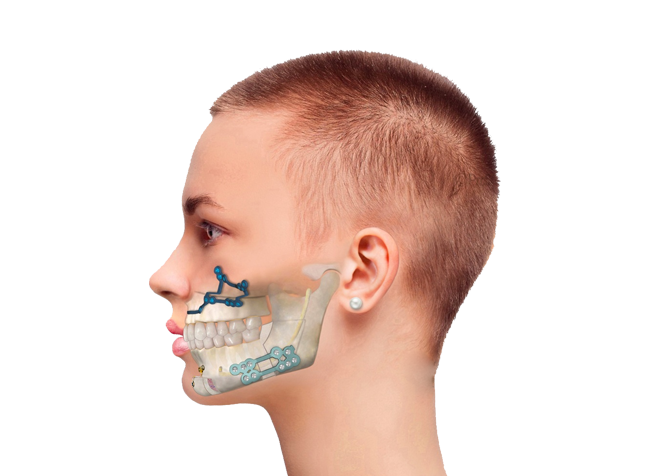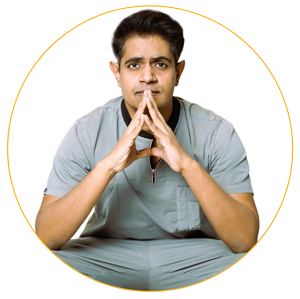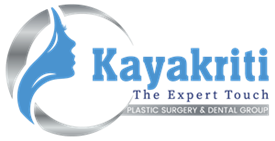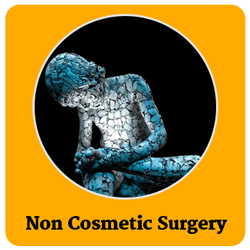Bi-Jaw Surgery
Bi-Jaw Surgery or Double Jaw Surgery is a type of orthognathic surgery.

Best Bi-Jaw Surgery in India
What is Bi-Jaw Surgery?
Bi-Jaw Surgery or Double Jaw Surgery is a type of orthognathic surgery in which jaw abnormalities involving both upper & lower jaws are corrected. It is also called Bimax jaw surgery. This procedure is done on both jaws to realign them for better cosmetic or functional results. Bi jaw surgery involves cutting both the upper and lower jaw which are either brought forward or backward depending on the correction required.
When Bi-Jaw Surgery is needed?
When cases of abnormal growth of the jaw, misaligned teeth, or abnormal shape after injuries cannot be corrected with Lefort osteotomy or Bilateral Sagittal Split Osteotomy (BSSO) alone as a single procedure, then Bi Jaw surgery is advised and done to attain better facial balance.
What are the most common deformities corrected with Bi-Jaw surgery are
- Severe mal-alignment of both jaws.
- Correction of Deepbite, Underbite, Open Bite, Overlapping jaws & Asymmetrical jaws
- Incorrect jaw position or size leads to misaligned teeth.
- Severe TMJ disorders with Impaired jaw function.
- Moderate to severe Obstructive sleep apnea.
- Gummy smile with the underdeveloped mandible.
- Severe maxillary (upper jaw) underdevelopment due to Cleft Lip and palate congenital deformity.
It is a specific type of orthognathic surgery or corrective jaw surgery, to correct both aesthetic & functional skeletal issues.
Bi-max surgery is routinely combined with chin surgery/genioplasty if required for better esthetics of the face.
When should you get Bi-Jaw Osteotomy Surgery
- Before performing orthognathic surgery, it is important to check that the skeletal growth is complete in both boys and girls which is usually 15 to 16 years in girls and 17 to 18 in boys.
- Upper jaw (Maxillary) growth usually ceases 2 years before lower jaw (mandibular) growth completion.
- Another contraindication to the above rule is in the case of a trauma that needs to be corrected immediately.
Planning for Bi-Jaw Surgery
Preoperative surgical planning is the key to successful surgery
A) Investigations
- 3D CT scan of the face
- Frontal and lateral photos of the face
- Cephalometric X-Ray of the face for soft tissue and bony measurements.
- Dental impressions are obtained to aid in formulating a diagnosis.
Out of all the mentioned investigations, Cephalometric X-rays are very important as it reveals abnormal growth patterns of the upper and lower jaws about the cranial base.
B) Analysis
Then a detailed analysis of the skeletal, dental, and soft tissue findings is done by Dr. Amit Agarwal and the orthodontist. Dental models are made and a mock surgery is done and acrylic occlusal splints are fabricated. These occlusal splints are used intraoperatively to accurately reposition the osteotomized maxilla.
C) Presurgical Orthodontic Treatment
In many cases, pre-surgical orthodontic treatment for about 7 to 10 months is required, which may be continued after the surgery depending on the case requirement.
Contraindications for Bi-Jaw Surgery
- Major medical comorbidities
- Cardiac diseases
- Presence of active dental infections
- A patient in the active growth phase
- Psychiatric diseases or uncontrolled seizure disorders
- The major difference between patient's and surgeon's goals and expectations
- Patients with a habit of smoking and substance abuse
- Questionable blood supply of the maxilla and mandible as seen in multiply operated patients (e.g. cleft palate) or patients with a history of radiation therapy
16 Steps for Surgical Procedure of Bi-Jaw Surgery
- This procedure is performed under general anesthesia with nasal endotracheal intubation. Local anesthesia (lidocaine 1% with 1:100,000 epinephrine) is also used to decrease blood loss.
- The incision is made inside the mouth to prevent visible scars on the face. One jaw is repositioned at a time during the surgery.
- In case of a jaw enlargement, a bone graft may be placed between the cut ends of the bone fragments to increase the size of the jaw and in case of a jaw reduction, some part of the bone may be removed.
- Titanium screws & plates are used to hold the jaws in position. Elastic bands and wires are as well used to keep the jaws in position.
- It is the surgeon's preference to decide whether the upper jaw needs to be worked upon first or the lower jaw. Dr. Amit Agarwal prefers to do BSSO first and then Lefort osteotomy.
Bilateral Sagittal Split Osteotomy (BSSO)
The surgeon makes cuts behind the last molar teeth diagonally and lengthwise down the jawbone so the front of the jaw can move as one unit.
- The cuts are made on the sides-right and left. 'Osteotomes' which are the separators, are used to split the jaw through these cut edges.
- To establish an improved bite, the protruding jaw can be moved backward or a retruded lower jaw can be moved forward.
- Therefore, once the jaws are separated, the lower jaw can be moved to its corrected position and fixed through screws & plates, with intraoral wiring done on the teeth for better positioning of the lower jaw in proper occlusion/bite.
- The incision is closed in layers with absorbable sutures
For LeFort Osteotomy
The upper jaw is cut above the level of the tooth roots & separated from the skull and facial bone.
- A lot of care is taken to know the location of the apices of the tooth and the pterygoid plates posteriorly while cutting.
- Proper clinical examination & X-rays are required to prevent damage to the teeth due to the maxillary separation.
- Temporary inter-maxillary fixation with elastics is done over pre-surgically made occlusion wafers.
- The surgically moved maxilla is fixed with the native bones of the face with the help of plates and screws and the incision is closed in layers with absorbable sutures.
- The jaws are not wired & shut for long, and the bone segments are fixed rigidly.
Recovery period in Bi-Jaw Osteotomy
The patient is wheeled out of the operation theatre in stable condition and kept in the post-operative recovery room for overnight monitoring. Facial swelling and bruising are common after this surgery which surely subsides within a week. Ice packs may be applied in the early postoperative period to minimize swelling.
How much time does it take to Recover?
- The patient is usually discharged after 3 to 4 days from the hospital and is instructed to follow up after a week
- Early postoperative occlusal changes which may be due to edema and muscular re-adaptation are common.
- The patient is to follow a strict postoperative regimen
- Thorough oral hygiene is critical with the use of a soft toothbrush and antibacterial mouth rinse.
What to do for faster Recovery?
- Soft diet for 4 to 6 weeks starting with liquids for about a week.
- Antibiotic treatment is continued for one week.
- Soft elastics are placed between the upper and the lower jaw to hold the upper Jaw in the new position.
- The patient is instructed to avoid forceful nose blowing for three weeks
The main role of postsurgical orthodontics is to settle teeth into their final occlusion. The length of postoperative orthodontic treatment will vary, depending on the presurgical setup, the accuracy of planned surgical movements, and the final occlusal result. A general goal by most orthodontists is to complete all postsurgical orthodontics within 9 months.
Risks and Complications of Bi-Jaw Surgery
Bi-Jaw/ Bi-Max surgery is a safe and reliable surgery but can lead to a few complications which are described below-
- Bleeding.
- Infective complications such as Abscess formation
- Anterior open bite in the early or late postoperative period
- Dental and periodontal injuries
- Oro nasal fistula
- Partial or total nerve injury to the infraorbital nerve with sensory loss to the upper lip, cheeks, and nose
- Alterations in the appearance of the face including widening of alar bases and changes in nasal tip position.
- Increased nasal airway resistance due to constriction of internal nasal valve with maxillary superior repositioning
- Pain and congestion with rare infections leading to maxillary sinusitis
- Non-union of bony segments
- Unfavorable fractures of the upper or lower jaw.
- Partial or total nerve injury to the inferior alveolar nerve with sensory loss to the lower lip and teeth
- TMJ dysfunction or condylar malposition
- Malocclusion- If the aetiology of the malocclusion is related to improper placement of the maxilla, failed hardware, or condylar malposition, revision surgery is indicated.
- Retraction of the gingiva.
- Rarest complication of Necrosis of the maxilla, unilateral blindness and Occulomotor nerve palsy.
Know your surgeon better

Best plastic surgeon, Dr. Amit Agarwal is an American Board Certified, extensively trained, and best Plastic & Aesthetic surgeon in Lucknow. He is the Chief Plastic Surgeon heading the Department of Plastic, Microvascular, and Craniofacial surgery at Vivekananda Polyclinic and Institute of Medical Sciences, Lucknow, U.P, India. He maintains a busy practice at Avadh and Nishat Hospital and his own center - Kayakriti Plastic Surgery & Dental Center. He was formerly a Consultant in the Department of Plastic Surgery and Burns at the prestigious SGPGI, Lucknow.
MS, DNB (General Surgery) MCh, DNB (Plastic Surgery),
MNAMS, FACS, FICS, FRCS (Edinburgh, UK)
His Credentials
Three pillars of kayakriti
Privacy
We believe your experience with us should be comfortable and hassle-free to make it one of your best lifetime experiences for yours. We, here at the clinic, take full precautions to maintain your privacy in any manner. We also provide a staff who will receive you from the gate and take you to the chamber directly if you demand.
Trust
Our Surgeon is highly qualified and internationally certified with a team of skilled staff to perform any surgical or non-surgical treatment on your body.
Safety
When you plan to undergo any surgery you should always keep in mind that it's your body and it's a surgery. We, here always keep your safety a priority and will never recommend you to undergo any such procedure which is not safe for you. We also provide you with a detailed description of the complications which may occur after the surgery during the consultation as it's a surgical procedure so there may be some complications depending on the way your body reacts.
Kayakriti in news



Frequently Asked Questions
If you have flat or small breast and you want to improve your breast and hip contour ratio then you are a good candidate for it. The answer will be best provided after the first consultation with Dr Amit Agarwal.
Acute pain will be there for almost a week which gradually reduces and there will be soreness and swelling which may take up to 3 weeks to subside.
You can join your work and daily routines after a week of the procedure and can start exercising after 3 weeks of it.
Yes, you have to wear it round the clock unless we suggest you to remove it.
This surgery does not affect the ducts or the areas of the breast involved in milk production. Thus, it does not affect the breast feeding.
This surgery does not affect the ducts or the areas of the breast involved in milk production. Thus, it does not affect the breast feeding.












Kayakriti Plastic Surgery & Dental Center
D-43, Near Punjab National Bank, Rajajipuram, Lucknow, Uttar Pradesh - 226017, India
Phone No. +919695940009, +919695940006
Map Location





























Social Media Presence